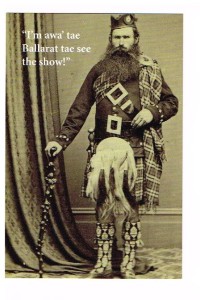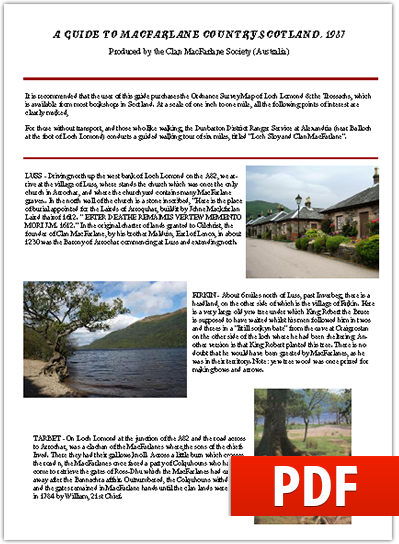 We had a great day out in Ballarat yesterday despite the blustery weather conditions. As the rain pelted down outside, my husband and I tucked into a light lunch at the Art Gallery Cafe in Ballarat before visiting the “For Auld Lang Syne” exhibition which is due to close on 27th July.
We had a great day out in Ballarat yesterday despite the blustery weather conditions. As the rain pelted down outside, my husband and I tucked into a light lunch at the Art Gallery Cafe in Ballarat before visiting the “For Auld Lang Syne” exhibition which is due to close on 27th July.
This is a magnificent collection of artwork and objects illustrating the significant contribution that Scots have made to Australia. The items on display are too numerous to list but some that caught my eye were: read more…
Scotland and the Slave Trade
We take a brief look at the part played by many Scots who became wealthy due to their close involvement with slave labour.
It has always been a ‘bone of contention’ in my mind just why ~ in my generation ~ the Scottish education system seemed to teach so little about the real history of my country. During the 1930s the subject of History focused heavily on broader aspects of the then British Empire, as depicted by all the ‘pink’ areas of a world atlas ~ but even here it seems that certain subjects, were, to say the least, never highlighted to any great extent.
Britain’s involvement with the African slave trade seemed forever a subject carefully edited for public consumption. As a child, I honestly believed that Brits were God’s own disciples, going forth to spread enlightenment among the less fortunate of our earthly brethren. The possibility that so many of the same brethren were being cruelly exploited never entered my mind.
In later life, it came as something of a shock to learn that many Scottish plantation owners became rich on the backs of unfortunate black African slaves, particularly in the Caribbean area.
It is estimated that 20,000,000 Africans were bought or captured in Africa and transported to the Americas. The Scottish-Caribbean link is centuries old, but from the beginning of the 18th century it expanded rapidly, until Britain eventually controlled the West-Indies ~ and Scottish slave owners played a prominent part in what was described as Chattel Slavery.
To read the full article (orginally published in MacFarlane’s Lantern No. 112, December 2009) please click on the following link:
MacFarlanes at Bannockburn?
Whilst this year Scotland celebrates the 700th Anniversary of the Battle of Bannockburn on 24 June 1314, we search for Clan MacFarlane.
A fair number of MacFarlanes from all over the world will visit Scotland this year and take part in the Remembrance activity being re-enacted near the battle site, of 1314. However, a question arises; did Clan MacFarlane take part in the actual battle of Bannockburn all those 700 years ago?
MacFarlanes who know the basics of their Clan’s history will be aware that our lineage stems as a branch of the ancient Celtic Earls of Lennox. Our first clan chief was one Gilchrist, who was the fourth son of Alwyn, 2nd Earl of Lennox, and who in 1225 received the lands and barony of Arrochar in Dunbartonshire from his brother Malduin (3rd Earl).
To read the rest of this article, which was published in MacFarlane’s Lantern No. 130 – June 2014, please click on the following link:
A full copy of the current newsletter (and back issues) are also available in the Members Area.
“MacFARLANE, Misses. They were listed as teachers in the 1824 Aberdeen Directory at Retties Court, 26 Broad Street.”
The above entry was found in Aberdeen Female Teachers pre-1872: a biographical list by Alison T. McCall, published by the Aberdeen and North East Scotland Family History Society and winner of their Bruce Henderson Award for 2012.
Can anyone provide any further information on these women?
Education was not made compulsory until the Education (Scotland) Act 1872 but there were a variety of schools in existence before then. These schools were either run by the local church, a charity, the Town Council or privately. The smaller ones were run from home and had less than a dozen students whilst the larger ones could have as many as several hundred pupils. Some schools were for a single sex, others were mixed (generally for younger students) and others were divided into separate departments for boys and girls. These early female teachers varied in age, marital status and family background, but they all faced the same stigma as “new women” who forged a career at a time when society expected them to focus on finding a husband. As there were no special colleges to train teachers until 1873, these women showed great determination in travelling away from home for two years to attend College, often as far away as Edinburgh.
The author of the book, Alison T. McCall, urges those researching the women in their family to check the publication list of the Aberdeen and North East Scotland Family History Society for other relevant books.
The 18th century was of particular importance to Scotland as a whole, during the first decade of which the Scots lost the power to govern themselves. Indeed, many still argue that the Act of Union in 1707 was inflicted on the majority of Scots by an influential and very wealthy minority that constituted the then ruling establishments on both sides of the Border.
Certainly there is ample evidence to suggest that many acts of chicanery, bribery and various shades of corruption were rife among politicians during the run up to the event…..
Read the full article (originally published in MacFarlane’s Lantern No. 127, September 2013) by clicking on the link below.
THE STRANGER-GAELS : A look at Norse influence in the northern Highlands and Islands of Scotland
It is important to to note that, from about the mid-9th century until 1266, much of the northern mainland and outer isles of Celtic Scotland had fallen to Norse control. Vikings from Scandinavia (Norway, Sweden and Denmark) had appeared first as raiders and pirates in search of plunder, but later came as settlers.
Norsemen largely dominated what are now Caithness, Sutherland and a great portion of what would become Ross (later Ross-shire). Along with the Orkney and Shetland Isles, these lands formed part of the earldom of Orkney, initially ruled by powerful Norwegian jarls (earls) on behalf of the kings of Norway.
From the time of Kenneth MacAlpin (844-858) successive Scottish kings struggled continuously to annex these northern lands to Scotland. For a while, at least until annexation became a reality, there existed a kind of diplomatic ‘understanding’ between the kings of Scots and the Orkney jarls. Indeed a daughter of King Malcolm II (1005-1034) married Sigurd II., Jarl of Orkney.
Read the full article by Calum Curamach (originally published in MacFarlane’s Lantern No. 128, December 2013) by clicking on the link below.
The first real attempt to form a Scottish colony in Canada began in the early 17th century when Sir William Alexander (later Earl of Stirling) encouraged King James VI and I to authorise the setting up of a New Scotland (Nova Scotia) across the Atlantic. This was to become Scotland’s answer to the already flourishing New England in North America.
In 1621, Sir William obtained a grant of considerable territory, embracing what are now New Brunswick, Nova Scotia, and the Gaspe Peninsula. To further encourage settlement on the lands, a new Order of nobility was instituted, namely Baronets of Nova Scotia, a title which could be bought by anyone with sufficient funds.
To qualify, each applicant was obliged to pay 3,000 marks for the title, and further to equip and send six men to the new colony, presumably with their wives and children. In return, the baronet received 16,000 acres of land.
Between 1625 and 1707, some three hundred such titles had been bought, but the scheme failed to excite colonists. Moreover, fierce resistance from French settlers already established on much of the land confronted those who did take up the offer to emigrate. Thus, the idea was finally scrapped when King Charles I surrendered the territory to France in 1632. It was not until the late 19th century that large numbers of Scots began to settle in Nova Scotia and other parts of Canada.
Read the full article by Calum Curamach (originally published in MacFarlane’s Lantern No. 129, March 2014) by clicking on the link below.
The Scottish Societies and Clans of Victoria 62nd Annual Ball will be held on Saturday, 3rd May 2014 at the Coburg Town Hall.
Tickets are priced at $60 per person ($15 for children) and include a three course dinner.
Entertainment includes:
Highland Pipe Band * Highland Dancing Display * Scottish Country Dancing * Old Time Dancing to the ‘Hat Band’
Please click on the following link for further details:
Scottish Societies and Clans of Victoria Highland Ball
Comunn Gaidhlig Astrailia (Scottish Gaelic Association) is supporting a campaign to raise a part- time lecturer.
Your tax deductible donation to this charitable fundraising registered fund would be most appreciated.


